 Purdue University - Extension - Forestry and Natural Resources
Purdue University - Extension - Forestry and Natural Resources
Got Nature? Blog
Kara Salazar has been promoted to Assistant Program Leader for Purdue Extension Community Development. She has served in this role part-time but will now be fully dedicated to this program area. Kara will maintain her 25% appointment with Illinois-Indiana Sea Grant (IISG) and serve on the Agriculture Natural Resources (ANR) Extension Advisory Committee. She will still be located in the Forestry Building (FORS 308) and affiliated with the Department of Forestry and Natural Resources (FNR).
Working with multidisciplinary teams, Kara oversees the development and delivery of programs to support environmental planning, community development, and sustainable development strategies in communities across Indiana and the Great Lakes states. Kara provides leadership to the Purdue Extension Community Development Program and serves as a liaison between Illinois-Indiana Sea Grant and Purdue Extension.
Kara has a B.S. in public affairs and environmental science and a M.P.A. in natural resources management and nonprofit management from the Indiana University School of Public and Environmental Affairs. She also received a M.S. Ed . degree from the IU School of Education at Indiana University-Purdue University Indianapolis (IUPUI) with concentrations in community building and science education. Additionally, she is a Ph.D. candidate in Natural Resources Social Science at Purdue University. Kara is a member of the American Institute of Certified Planners (AICP), a Climate Change Professional (CC-P), and a Professional Community and Economic Developer (PCED) with credentials from LEED AP Neighborhood Development, the National Green Infrastructure Certification Program (NGICP), and the National Charrette institute.
Congratulations to Kara in her new position as she continues to move Purdue Extension and IISG forward with her expertise and team building.
Check out Kara’s lead role in the following programs and learn about the vast resources available:
Purdue Extension Community Development – strengthens the capacity of local leaders, residents, businesses, and organizations to build resilient, inclusive and sustainable communities through research-based resources and processes. Examples of a few of the programs and resources available include: Leadership and Civic Engagement, Community and Organizational Planning, Economic and Business Development.
Illinois-Indiana Sea Grant (IISG) – utilizes research, outreach, and education to bring the latest science to Great Lakes communities and their residents. By connecting decision-makers with science, we help strengthen and preserve ecosystems and communities in southern Lake Michigan and beyond.
Agriculture & Natural Resources (ANR), Purdue Extension – ANR Educators serve as research based, unbiased information source for county and state constituents on a variety of topics including: crops, ag business, livestock, natural resource, horticulture, small farms, urban ag, pesticide use, and land conservation.
Purdue Extension – a leader in providing relevant, high-impact educational programs that transform he lives and livelihoods of individuals and communities in Indiana and the world. Purdue Extension – Forestry & Natural Resources (FNR) is a branch of the Cooperative Extension Service/Purdue Extension. FNR Extension provides resources for aquaculture, fish management, urban and forestry management, natural re source planning, wildlife, and sustainable biomaterials. We encourage you to browse, download free publications, utilize our Ask an Expert, subscribe to Got Nature? newsletter and view upcoming workshops.
Sustainable Communities Extension Program (SCEP) – provides multidisciplinary teams focusing in the following areas: Placemaking and Enhancing the Value of Public Spaces; Land use Planning Education; Green Infra structure; Community Development; American Citizen Planner; Facilitation and Strategic Planning; Conservation Through Community Leadership; Rainscaping Education and Tipping Point Planner.
More Resources including Kara’s publications and videos:
Implementation Examples of Smart Growth Strategies in Indiana, The Education Store, Purdue Extension’s resource center
Conservation Through Community Leadership, The Education Store
Climate Change and Sustainable Development, The Education Store
Climate Change: Are you preparing for it?, The Education Store
Tipping Point Planner, The Education Store
Enhancing the Value of Public Spaces, The Education Store
Enhancing the Value of Public Spaces: Creating Healthy Communities, The Education Store
One Water Approach to Water Resources Management, The Education Store
Rainscaping Education Program, Purdue Extension
Conservation Through Community Leadership, Sustainable Communities Extension Program (SCEP)
Community Planning Playlist, Purdue Extension-Forestry & Natural Resources (FNR) YouTube Channel
Rainscaping and Rain Gardens, Purdue Extension YouTube Channel
Conservation through Community Leadership, Purdue Extension You Tube Channel
Enhancing the Value of Public Spaces Program, Purdue Extension YouTube Channel
Tipping Point Planner, Purdue Agriculture YouTube Channel
Indiana Creek Watershed Project – Keys to Success, Partnerships and People, Purdue Extension You Tube Channel
Subscribe to Purdue Extension – Forestry and Natural Resources YouTube Channel
Diana Evans, Extension and Web Communication Specialist
Purdue University Department of Forestry and Natural Resources
The Purdue Rainscaping Education Program introduces two new videos as they continue to provide training and resources on rainscaping practices that can be installed in residential settings or small-scale public spaces projects.
Rainscaping and Rain Gardens
Rainscaping is a combination of sustainable landscape design and management practices that prevents polluted runoff from reaching water bodies — directing stormwater to be absorbed by plants and soils.
Rainwater Harvesting with Cisterns
This video demonstrates how rainwater can be harvested with cisterns for future use in your landscaping and gardens.
Rainscaping is a combination of sustainable landscape design and management practices that prevents polluted runoff from reaching water bodies — directing stormwater to be absorbed by plants and soils. Learn more about rainscaping and demo rain gardens at: Purdue Rainscaping Education Program.
Resources:
What is Rainscaping? Purdue Rainscaping Education Program Video, Purdue Extension
Sustainable Communities Extension Program, Purdue Extension
Q&A About Drainage Water Recycling for the Midwest, The Education Store, Purdue Extension resource center
Rainscaping Playlist, Purdue Extension – Forestry and Natural Resources (FNR) YouTube Channel
Ask an Expert: Rainscaping, Purdue Extension – FNR YouTube Channel
Rain Gardens Go with the Flow, Indiana Yard and Garden, Purdue Horticulture
Become a Purdue Master Gardener, The Education Store
Master Gardeners Program
Plan Today For Tomorrow’s Flood, The Education Store
John Orick, Purdue Master Gardener State Program Coordinator
Department of Horticulture & Landscape Architecture
Kara Salazar, Assistant Program Leader and Extension Specialist for Sustainable Communities
Department of Forestry and Natural Resources
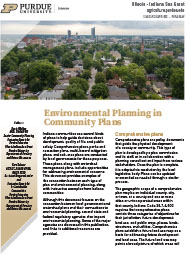
Indiana communities use several kinds of plans to help guide decisions about development, quality of life, and public safety. Comprehensive plans, parks and recreation plans, multi-hazard mitigation plans, and sub-area plans are conducted by local governments for these purposes. This Environmental Planning in Community Plan include opportunities for addressing environmental concerns. This document provides examples of the connection between each type of plan and environmental planning, along with instructive examples from Indiana communities.
Although this document focuses on the connection between local government and watershed plans and their connections to environmental planning, several state and federal regulatory agencies also impact environmental planning. Some of the major agencies are discussed in this publication, and links to additional resources are provided.
Communities create comprehensive plans to guide decisions about development, quality of life and public safety, parks and recreation plans, multi-hazard mitigation plans, and sub-area plans. Such plans include opportunities to address environmental concerns. Using instructive examples from Indiana communities, this publication examines the connection between those plans and environmental planning.
Resources:
Sustainable Communities Extension Program Website, Purdue Extension
Enhancing the Value of Public Spaces Program Video, Purdue Extension
Community Planning, Purdue Extension Community Development
Implementation Examples of Smart Growth Strategies in Indiana, The Education Store, Purdue Extension’s resource center
Climate Change and Sustainable Development, The Education Store
Enhancing the Value of Public Spaces: Creating Healthy Communities, The Education Store
Subscribe to Purdue Extension – Forestry and Natural Resources YouTube Channel
Dan Walker, Community Planning Extension Specialist
Purdue Department of Forestry and Natural Resources
Kara Salazar, Assistant Program Leader and Extension Specialist for Sustainable Communities
Purdue Department of Forestry and Natural Resources
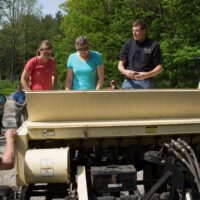 Jarred Brooke, wildlife extension specialist, was featured in the April 2022 Agriculture & Natural Resources (ANR) newsletter. Jarred continues to share workshops and resources for the state of Indiana and beyond, with topics including prescribed fire, planting native grasslands, habitat management, wildlife management for landowners, utilizing drones and much more.
Jarred Brooke, wildlife extension specialist, was featured in the April 2022 Agriculture & Natural Resources (ANR) newsletter. Jarred continues to share workshops and resources for the state of Indiana and beyond, with topics including prescribed fire, planting native grasslands, habitat management, wildlife management for landowners, utilizing drones and much more.
ANR Newsletter April 2022: Featured Extension Specialist – Jarred Brooke
What do 79% of Indiana woodland owners have in common? They agree providing wildlife habitat is an important reason they own land – making it the 2nd most common reason for owning a woodland, according to a 2018 national survey. And more than just woodland owners are interested in wildlife. Many agriculture producers are keenly interested in wildlife conservation. Jarred Brooke has built his extension program around this idea – wildlife are important to private landowners, and private landowners are important to wildlife.
Habitat Management Education Through Experiential Learning
Embracing the “Learn by Doing” approach of 4-H, Jarred is involved in several wildlife habitat management workshops and field days emphasizing experiential learning opportunities. These range from forestry and wildlife field tours to live prescribed fire demonstrations. One such program is the “Learn-N-Burn” workshops.
Jarred has partnered with Extension Educators and Specialists, Soil and Water Conservation Districts, and Indiana DNR and Pheasants Forever Biologists to host workshops to help landowners understand the importance of prescribed fire in managing grasslands and woodlands. Participants are treated to a live prescribed fire demonstration during the workshop (weather permitting). Attendees of these workshops own or manage more than 23,000 acres, their knowledge about prescribed fire increased from 37-125%, and 94% of attendees agreed the workshops helped them make decisions on their property.
Moving Natural Resources Extension Digital
Jarred has also been involved in several projects to create digital extension resources. This includes being part of an Issue-Based Action Team that published multiple pond and wildlife management publications, videos, created a pond and wildlife management website, and a tool to help landowners find natural resource professionals in their county. He is also part of a team that helped develop the Purdue FNR Ask-the-Expert Facebook Live program, which has received more than 28,000 views.
Taking to the airwaves, Jarred is part of the multi-state team that created the Natural Resources University (NRU) Podcast Network. He co-hosts the Habitat University podcast with the Extension Wildlife Specialist at Iowa State University. NRU podcasts have received 123,000 downloads in 50 states and 63 countries. A survey of Habitat University listeners indicated they plan to apply or have applied information from the podcast to over 19,000 acres of land.
Train-the-Trainer: Reaching Private Landowners Through Conservation Partnerships
Jarred collaborates with other FNR Extension Specialists and Indiana conservation partners to deliver conservation training programs. These programs are aimed at helping natural resources professionals deliver conservation programs like the Conservation Reserve Program. For example, Jarred works with the Natural Resources Conservation Service to create and provide native grass establishment and management trainings. Jarred helped develop six of these workshops for 164 professionals. More than 95% of participants agreed their future native grass establishment and management recommendations would improve after attending these workshops.
Jarred’s extension efforts aim to help landowners become better stewards of Indiana’s wildlife resources by helping them acquire the knowledge to make sound decisions on their property.
View full ANR Newsletter.
Resources:
Frost Seeding to Establish Wildlife Food Plots & Native Grass and Forb Plantings, video, The Education Store, Purdue Extension Resource Center
Calibrating a No-Till Drill for Conservation Plantings and Wildlife Food Plots, video, The Education Store
Renovating native warm-season grass stands for wildlife: a land manager’s guide, The Education Store
Creating a Wildlife Habitat Management Plan for Landowners, The Education Store
Purdue Extension Pond and Wildlife Management Website, Purdue Extension
Subscribe: Purdue Extension – FNR YouTube Channel, includes videos: Ask an Expert-Prescribed Fire, Ask an Expert-Handling Harvested Deer and more
Upcoming Purdue Extension-FNR Events, Purdue Extension-Forestry & Natural Resources (FNR)
Henry Quesada, FNR Professor, Assistant Directory of Extension and ANR Program Leader
Purdue Extension
Jarred Brooke, Wildlife Extension Specialist
Purdue Forestry and Natural Resources
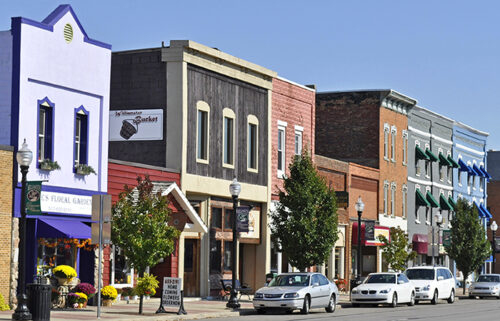 The Enhancing the Value of Public Spaces: Creating Healthy Communities Team, has been honored for its efforts by the Purdue Cooperative Extension Specialists’ Association (PUCESA).
The Enhancing the Value of Public Spaces: Creating Healthy Communities Team, has been honored for its efforts by the Purdue Cooperative Extension Specialists’ Association (PUCESA).
The collaborative effort of Purdue Extension professionals from Forestry and Natural Resources, Health and Human Sciences, Supplemental Nutrition Assistance Program – Education Division (SNAP-Ed), and Community Development, as well as Illinois-Indiana Sea Grant, earned recognition as a PUCESA Team Award honoree.
The EVPS: CHC campus leadership team consisted of:
- Blake Connolly, assistant director of Purdue Extension, Nutrition Education program
- Lisa Graves, assistant program leader, Purdue Extension, Health and Human Sciences
- Kara Salazar, Assistant Program Leader for Community Development and Sustainable Communities Extension Specialist, Purdue Extension, Illinois-Indiana Sea Grant and Purdue FNR
- Daniel Walker, Community Development Regional Educator, Purdue Extension, Illinois-Indiana Sea Grant
- Michael Wilcox Jr., assistant director and program leader, Purdue Extension, Community Development
The Enhancing the Value of Public Spaces program provides Extension professionals with the information, tools, processes and research base needed for them to guide decision-makers and local leaders with oversight and management of community public spaces and public health. The program aims to help participating communities recognize public spaces as community assets; understand the significant influence of the built environment on the health of people and places in their community; develop and implement change strategies and indicators to support the process of creating Healthy Eating and Active Living environments; and to integrate public spaces into communities’ planning and development activities to contribute to the process of creating a healthy, thriving and sustainable community.
Program implementation may involve parks board and planning commission members, public officials and their staff, and members of organizations involved with programming or management of public spaces. Health coalitions and other organizations working in the realm of active living and healthy eating also play a key role.
Resources:
Sustainable Communities Extension Program Website, Purdue Extension
Enhancing the Value of Public Spaces Program Video, Purdue Extension
Subscribe to Purdue Extension – Forestry and Natural Resources YouTube Channel
Wendy Mayer, FNR Communications Coordinator
Purdue University Department of Forestry and Natural Resources
Kara Salazar, Assistant Program Leader for Community Development and Sustainable Communities Extension Specialist
Purdue Department of Forestry and Natural Resources/Illinois-Indiana Sea Grant
Dan Walker, Community Development Regional Educator
Purdue Department of Forestry and Natural Resources/Illinois-Indiana Sea Grant
Question: Can I plant grass over soil where a newly removed stump was ground out?
Answer: We generally don’t want to plant new trees or turf immediately over the top of existing stumps in landscapes. The reasoning is a bit complicated but somewhat simple. The stump 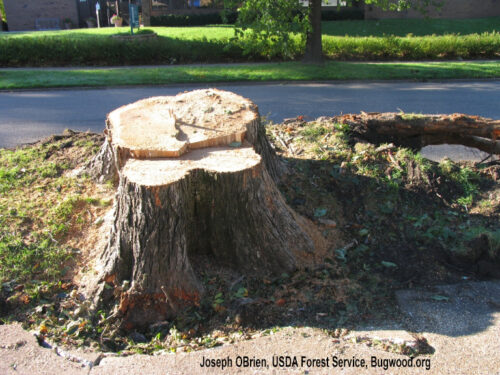 location will have limited soil and rooting depth for nutrient uptake and structural stability due to its remaining below ground mass.
location will have limited soil and rooting depth for nutrient uptake and structural stability due to its remaining below ground mass.
The woody debris material created from stump grinding has a high carbon to nitrogen (C:N) ratio. This reduces nitrogen availability for the new tree or grass. Also, there will be significant settling of the ground below the stump as it decays and loses its structural fiber. The soil should be added to replace the below ground roots and stump. It can take several years to fully decompose the stump unless it was ground very deeply or removed with an excavation machine.
The recommendations are adding soil to the stump area, and a little additional soil mounded to compensate for some decay. Plant the grass, preferably sod, however, seed can work, to adequately cover the newly exposed area. Be sure to add slow-release turf fertilizer to compensate for the high C:N ratio that will be robbing nutrition from the newly installed turf. Maintain adequate moisture and look for signs of yellowing, indicating low nitrogen levels.
Also, sprouts may be generated due to the roots acting as energy storage for the tree. Simply treat them with typical lawn herbicide as needed at the label recommended rates.
Resources:
Fundamentals of Turfgrass Management, The Education Store, Purdue Extension Resource Center
Taking Care of Your Yard: Homeowner’s Essential Guide to Lawns, Trees, Shrubs, and Garden Flowers, The Education Store, Purdue Extension Resource Center
Homeowner Conservation Practices to Protect Water Quality, Purdue Rainscaping, Purdue Extension Resource Center
Planting Your Tree Part 1: Choosing Your Tree, Purdue Extension YouTube Channel
Purdue Landscape Report
Lindsey Purcell, Chapter Executive Director
Indiana Arborist Association
Most of us have probably heard or seen a lot about pollinators in the media recently. The reason why is that pollinators are really, really important. We simply can’t live without them. Researchers estimate that one out of every three bites of food we eat is made possible by pollinators. More than 100 food crops in the U.S. depend on pollinators, including almost all fruit and grain crops.
There are many different types of pollinators including native bees, butterflies and moths, beetles, flies, wasps, and of course hummingbirds. But perhaps one of the more interesting pollinators is the Monarch. Millions of Monarchs congregate in a relative small area in Mexico each winter. In March they start their journey north which has occurred over several generations. Unfortunately, the number of Monarchs counted in overwintering colonies has declined over the past 25 years.
In response, many states including Indiana have developed a state Monarch Conservation Plan. With input from many stakeholders over several years, the Indiana Monarch Conservation Plan was released in December 2020. One goal of the plan was to create an online resource that would act as a clearinghouse for Indiana monarch and pollinator conservation data, research, best management practices (BMPs), and events. I invite you to visit the Indiana Monarch and Pollinator Conservation Hub at https://indianawildlife.org/monarchs/.
You might be asking yourself, ‘Why is a wildlife specialist writing about pollinators?’ It turns out that quality habitat for wildlife is often quality habitat for pollinators. The diversity of wildflowers and structure that native grasslands, trees and shrubs benefit them all. Trees such as eastern redbud and Ohio buckeye provide early nectar sources. Native grasslands that have a diverse mixture of wildflowers provide food, bare ground, and structure desirable for a wide variety of pollinators.
Resources
Protecting Pollinators: Why Should We Care About Pollinators?, The Education Store, Purdue Extension resource center
Ask The Expert: What’s Buzzing or Not Buzzing About Pollinators , Purdue Extension – Forestry & Natural Resources (FNR) YouTube Channel
Purdue Pollinator Protection publication series, Purdue Extension Entomology
Indiana Monarch & Pollinator Conservation Hub, Indiana Wildlife Federation
Monarch Watch, University of Kansas
100 Plants to Feed the Monarch/Other Resources Available, Xerxes Society for Invertebrate Conservation
Brian MacGowan, Wildlife Extension Specialist & Extension Coordinator
Purdue Department of Forestry and Natural Resources
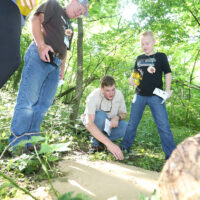 Purdue Extension wildlife specialist Jarred Brooke was honored by the College of Agriculture PK-12 Council on Thursday with the Staff Excellence Award for his work with PK-12 audiences to expand their interest in and preparation for careers in natural resource sciences.
Purdue Extension wildlife specialist Jarred Brooke was honored by the College of Agriculture PK-12 Council on Thursday with the Staff Excellence Award for his work with PK-12 audiences to expand their interest in and preparation for careers in natural resource sciences.The Council’s Outreach and Engagement Awards were established to recognize, reward and celebrate faculty and staff involved in successful outreach and engagement activities and to encourage the improvement and expansion of those activities.
“Winning this award is truly an honor,” Brooke said. “Working with PK-12 youth and youth educators is one of the most rewarding aspects of my job. Each time I see students or teachers have those ‘aha moments’ while connecting with nature it reaffirms that I chose the right career. I would not have been able to win this award if it were not for the help of my many great colleagues at Purdue, other universities, and beyond.
“Connecting youth with nature is so vital because their outdoor experiences now will shape how they view and understand nature as adults, ultimately influencing their willingness to protect and conserve the natural world in the future.”
Brooke, who earned his wildlife degree from Purdue Forestry and Natural Resources in 2012, joined the FNR staff in August 2016. His extension work impacting youth includes conservation field days, writing natural resources-based curricula for The Nature of Teaching signature program, and also planning and overseeing the 4-H and FFA Wildlife Habitat Education Program contest among other things.
Resources:
Nature of Teaching, Purdue Agriculture
Natural of Teaching YouTube Channel
Indiana 4-H Youth Development, Purdue Extension
4-H Academy, Purdue Extension
College of Agriculture PK-12 Council Outreach and Engagement Awards, Purdue Agriculture
National Wildlife Habitat Education Program (WHEP), Teaching Youth Valuable Skills
Jarred Brooke, Wildlife Extension Specialist
Purdue Department of Forestry and Natural Resources
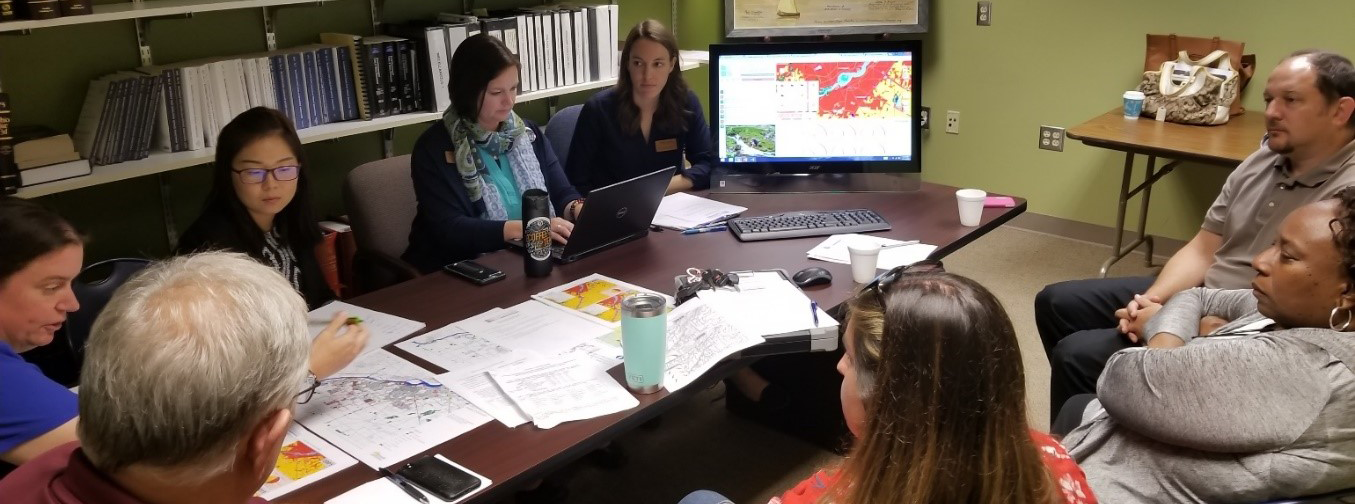 The Tipping Point Planner project, a joint effort by Illinois-Indiana Sea Grant and Purdue Extension, has been selected as a 2020 recipient of the Purdue College of Agriculture’s TEAM (Together Everyone Achieves More) Award.
The Tipping Point Planner project, a joint effort by Illinois-Indiana Sea Grant and Purdue Extension, has been selected as a 2020 recipient of the Purdue College of Agriculture’s TEAM (Together Everyone Achieves More) Award.
“The TPP program stands out because of its value and impact in assisting local communities in the Great Lakes Region,” Purdue Forestry and Natural Resources department chair Bob Wagner said in his nomination. “The program is unique in that it is composed of community activities dovetailed with a decision support system (DSS) that is based on user needs assessment. The TPP program has been in existence for nearly 10 years and has demonstrated outstanding innovation and impact. As an example, Esri recently showcased TPP as a model system that uses Esri technology to assist communities in important ways. This program highlights the success that both research and extension efforts can have when working closely together.”
The program was also recognized for its accomplishments in the Sustainable Use and Stewardship of Ocean and Coastal Resources segment of the National Oceanic and Atmospheric Administration’s 2019 Science Report, released in March.
The Tipping Point Planner was created to assist community leaders throughout the Great Lakes Basin in making long-term management decisions that affect environmental health of local resources and a community’s quality of life. The program, which includes a web-based decision support system, helps identify the status of watershed health by exploring land use, natural resources and environmental concerns, before determining the impacts of land-use decisions and management practices and, in turn, enables communities keep coastal ecosystems from reaching critical environmental limits, or tipping points, and becoming unstable.
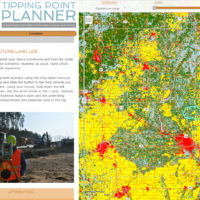 In 2019, the Tipping Point Planner team worked with communities in Au Gres, Michigan; and Perrysburg, Ohio, to create action plans regarding conservation and ecological resource management. All told, more than 100 people in these areas utilized the Tipping Point Planner and collaborated in making the community decisions.
In 2019, the Tipping Point Planner team worked with communities in Au Gres, Michigan; and Perrysburg, Ohio, to create action plans regarding conservation and ecological resource management. All told, more than 100 people in these areas utilized the Tipping Point Planner and collaborated in making the community decisions.
The science supporting TPP stems from multidisciplinary, collaborative work across several Big Ten universities and their associated Sea Grant and Extension offices. Lead researchers came from Purdue University, the University of Michigan, Michigan State University, the University of Illinois-Chicago, the University of Minnesota-Duluth, and NOAA’s Great Lakes Environmental Research Laboratory.
Team members secured more than $14 million in extramural funding from the National Science Foundation (NSF), Great Lakes Fishery Trust, EPA’s Science to Achieve Results Program, National Aeronautics and Space Administration (NASA), United States Geological Survey (USGS) Climate Change Program, Wege Foundation, and the Kellogg Foundation to enable the necessary data collection, modeling, survey work, and stakeholder interviews. The project also was funded as part of Purdue University Department of Forestry and Natural Resources’ (FNR) Signature Areas (2005-2011), which supported five FNR students working on various aspects of the project.
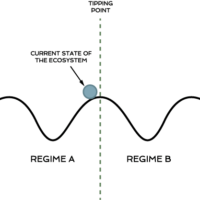 Dr. Bryan Pijanowski, professor of landscape and soundscape ecology; Kara Salazar, assistant program leader and extension specialist for sustainable communities; Lydia Utley, data analyst; and Daniel Walker, community planning extension specialist, are the project leaders for the Tipping Point Planner.
Dr. Bryan Pijanowski, professor of landscape and soundscape ecology; Kara Salazar, assistant program leader and extension specialist for sustainable communities; Lydia Utley, data analyst; and Daniel Walker, community planning extension specialist, are the project leaders for the Tipping Point Planner.The project also includes representatives from Purdue Agricultural and Biological Engineering, NOAA Great Lakes Environmental Research Laboratory and the Michigan State University Hydrogeology Lab. Other collaborators include the Eureka Aquatic Research, LLC; Michigan State University Center for Water Sciences, Michigan State College of Agriculture and Natural Resources, Michigan School for the Environment and Sustainability, the University of Albany College of Engineering and Applied Sciences, the University of Minnesota Duluth Natural Resource Research Institute and the U.S. Geological Survey Great Lakes Science Center.
The full Tipping Point Planner Team consists of:
NOAA Great Lakes Environmental Research Laboratory
- Dr. Edward Rutherford – Research Fishery Biologist
Purdue University Human-Environment Modeling & Analysis Laboratory
- Dr. Bryan Pijanowski – Professor
- Dr. Kristen Bellisario – Post-Doctoral Research Associate
- Dr. Kimberly Robinson – Former Graduate Student
- NahNah Kim, JD – Former Graduate Student
Purdue University Agricultural & Biological Engineering
- Dr. Bernard Engel – Professor and Department Head
- Dr. Larry Theller – Research Associate (Retired)
- Dr. Yaoze Liu – Postdoctoral Research Assistant
- Dr. Jingqiu Chen – Postdoctoral Research Associate
Michigan State University Hydrogeology Lab
- Dr. David Hyndman – Professor and Department Chair
- Dr. Anthony Kendall – Research Assistant Professor
- Dr. Sherry Martin – Research Associate
- Emily Luscz – Former Graduate Student
- Quercus Hamlin – Graduate Student
- Luwen Wan – Graduate Student
Michigan State University Center for Water Sciences
- Dr. R. Jan Stevenson – Professor and Co-Director of CWS
Michigan School for Environment and Sustainability
- Dr. Mike Wiley – Professor (Retired)
- Dr. Catherine Riseng – Professor
Eureka Aquatic Research LLC
- Dr. Hongyan Zhang – Aquatic Ecologist
USGS Great Lakes Science Center
- Dr. Yu-Chun Kao – Research Associate
University of Minnesota Duluth Natural Resource Research Institute
- Dr. Lucinda Johnson –Associate Director for Water
Illinois-Indiana Sea Grant
- Dr. Brian Miller – Director (Retired) and Project Manager
- Kara Salazar – Assistant Program Leader and Extension Specialist for Sustainable Communities
- Dan Walker – Community Planning Extension Specialist
- Lydia Utley – Data Analyst
- Ben Wegleitner – Former Outreach Assistant
Resources
Tipping Point Planner
Illinois-Indiana Sea Grant Tipping Point Planner
With GIS, Communities See How Land-Use Changes May Affect Local Water Quality
Tipping Point Planner curriculum available from Purdue Extension Education Store
Tipping Point Planner Online course
Tipping Points: What are they? Why are they important?
Tipping Point Planner
Kara Salazar, Assistant Program Leader for Community Development and Sustainable Communities Extension Specialist
Purdue Department of Forestry and Natural Resources/Illinois-Indiana Sea Grant
Join Purdue Extension forester Lenny Farlee and Dr. Carrie Pike, a forest regeneration specialist with the USDA Forest Service, as they share about conservation tree planting, what species are available to plant, where to get them and more.
If you have any questions regarding trees, forest management, wildlife, wood products or other natural resource topics, feel free to contact us by using our Ask an Expert web page.
Resources
Find An Indiana Forester Website
Reforestation, Nurseries and Genetics Resources Website (RNGR.NET)
A Nursery Guide for the Production of Bareroot Hardwood Seedlings, RNGR.NET
Landowner Information, Hardwood Tree Improvement Regeneration Center (HTIRC)
Ask An Expert, Playlist, Purdue Extension – Forestry and Natural Resources YouTube Channel
A Woodland Management Moment, Playlist
Ask An Expert: Tree Inspection, Video
Planting Forest Trees and Shrubs in Indiana, The Education Store, Purdue Extension resource center
Tree Appraisal and the Value of Trees, The Education Store
Investing in Indiana Woodlands, The Education Store
Forest Improvement Handbook, The Education Store
Lenny Farlee, Sustaining Hardwood Extension Specialist
Purdue University Department of Forestry and Natural Resource
Recent Posts
- Purdue Extension’s Showcase, Impacting Indiana
Posted: November 8, 2024 in Community Development, Forestry, Forests and Street Trees, Gardening, Land Use, Natural Resource Planning, Timber Marketing, Urban Forestry, Wildlife, Wood Products/Manufacturing, Woodlands - Natural Resources Commission Updates – Wild Bulletin
Posted: March 4, 2024 in Forestry, How To, Land Use, Natural Resource Planning, Plants, Wildlife, Woodlands - IAA Receives $250,000 Grant for Arborist Apprenticeship
Posted: February 21, 2024 in Forestry, Forests and Street Trees, Natural Resource Planning, Urban Forestry, Wildlife, Woodlands - Indiana Natural Resources Teacher Institute Workshop – Welcome to the Forest!
Posted: February 15, 2024 in Forestry, Natural Resource Planning, Nature of Teaching, Plants, Wildlife, Woodlands - Build a Better Habitat for Wildlife This Winter – Wild Bulletin
Posted: February 1, 2024 in Forestry, How To, Land Use, Natural Resource Planning, Plants, Wildlife, Woodlands - Hardwood Tree Improvement Regeneration Center (HTIRC) Shares Fall Newsletter, Research and Outreach
Posted: December 13, 2023 in Forestry, Land Use, Natural Resource Planning, Woodlands - Cost Assistance for Landowners Planning Conservation Practices
Posted: October 13, 2023 in Forestry, Invasive Plant Species, Natural Resource Planning, Woodlands - MyDNR: New multi-agency research partnership to benefit Indiana’s wildlife and wild places
Posted: September 7, 2023 in Aquaculture/Fish, Aquatic/Aquaculture Resources, Forestry, Natural Resource Planning, Plants, Wildlife, Woodlands - Purdue Extension to Connect Underserved Communities with Funding for Energy and Environmental Improvements
Posted: June 6, 2023 in Community Development, How To, Natural Resource Planning - Question: what resources do you have on wind energy, contracts?
Posted: April 11, 2023 in How To, Land Use, Natural Resource Planning
Archives
Categories
- Alert
- Aquaculture/Fish
- Aquatic/Aquaculture Resources
- Ask the Expert
- Christmas Trees
- Community Development
- Disease
- Drought
- Forestry
- Forests and Street Trees
- Gardening
- Got Nature for Kids
- Great Lakes
- How To
- Invasive Animal Species
- Invasive Insects
- Invasive Plant Species
- Land Use
- Natural Resource Planning
- Nature of Teaching
- Plants
- Podcasts
- Ponds
- Publication
- Safety
- Spiders
- Timber Marketing
- Uncategorized
- Urban Forestry
- Webinar
- Wildlife
- Wood Products/Manufacturing
- Woodland Management Moment
- Woodlands
